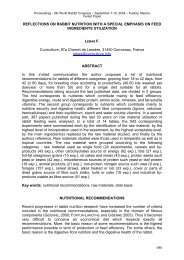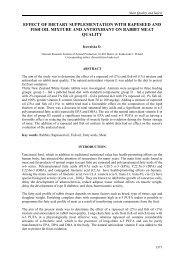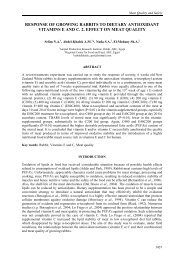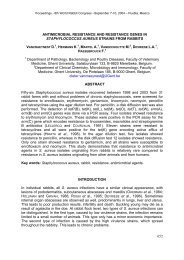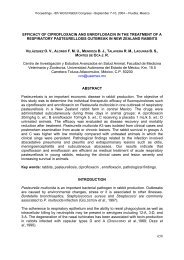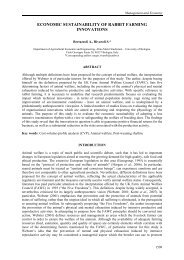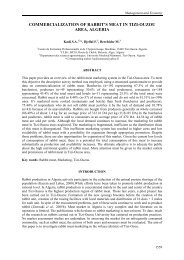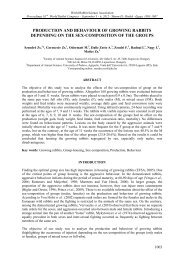Orheruata, A. M. - World Rabbit Science Association
Orheruata, A. M. - World Rabbit Science Association
Orheruata, A. M. - World Rabbit Science Association
Create successful ePaper yourself
Turn your PDF publications into a flip-book with our unique Google optimized e-Paper software.
Nutrition<br />
This study was therefore carried out to examine the effect of dietary manipulation of rabbits at<br />
different post-weaning ages on subsequent body weight.<br />
Experimental site<br />
MATERIALS AND METHODS<br />
The experiment was carried out in the rabbit unit of the University of Benin - Teaching and Research<br />
Farm, Benin City, Nigeria, located between latitudes 6ºand 6.30º N of the equator and longitudes 5.40º<br />
and 6ºE of the Greenwich Meridian. In the humid rainforest zone of Nigeria, annual temperature<br />
ranges between 24.5and 32.7 ºC with a mean value of 27.6 ºC. Annual rainfall ranges from 1498to<br />
3574mm with a mean value of 2162 mm. The relative humidity and daily sunshine are between 63.3<br />
and 81.71% and 5.85 and 7.5 hours with mean values of 72.5% and 6.68hours, respectively<br />
(NAA,2010).<br />
Animals, experimental diets and procedures<br />
Forty 28 days old weaned rabbits with average weight of 0.321±0.095kg from heterogeneous<br />
population (crosses of New Zealand White, New Zealand Red, Chinchilla, Californian, and Dutch<br />
breeds) were sourced from rabbit breeders in Benin City and in the Northern part of Nigeria and<br />
randomly allocated to four different dietary treatments (10/treatment).<br />
A diet of 12% CP and 3238kcalME/kg was formulated as the control diet while another diet of 16%<br />
CP and 2906kcalME/kg was formulated as the experimental diet. The composition and estimated<br />
values of the diets are presented in Table 1. Dietary treatments were as follows: Treatment 1:16% CP<br />
diet given between weaning (4 weeks) and 8 weeks of age, Treatment 2: 16% CP diet given between 8<br />
and 12 weeks of age, Treatment 3: 16 % CP diet given between 12 and 16 weeks of age, and<br />
Treatment 4: control diet of 12 % CP, which was fed from weaning to 24 weeks of age. The control<br />
diet was fed at all other times when the experimental diet was not being fed to 24 weeks of age. In all<br />
treatments, forage (a mixture of grasses and legumes: Panicum maximum, Tridax procumbens, Ipomea<br />
batatas leaves and Centrosema pubescens) was made available in the hutch.<br />
Table 1: Composition of the diets.<br />
Feed ingredients (%) Experimental diet Control diet<br />
Maize 60.00 84.00<br />
Groundnut cake 16.00 10.00<br />
Palm kernel cake 6.00 2.00<br />
Brewer’s dry grain 14.00<br />
Bone meal 2.50 2.50<br />
Limestone 1.00 1.00<br />
Vitamin premix 0.15 0.15<br />
Salt 0.35 0.35<br />
Estimated composition (%)<br />
Metabolizable energy (kcal/kg) 2,906 3,238<br />
Crude protein 16.21 12.38<br />
Ether extract 4.4 3.95<br />
Crude fibre 6.87 3.33<br />
Minerals (ash) 2.28 1.56<br />
Nitrogen free extract 57.63 66.70<br />
Individual body weights(BW) were weekly taken from weaning to 24 weeks of age using a 5 kg<br />
capacity kitchen scale. Weight data were subjected to analysis of variance using the GLM procedure<br />
of SAS (2004) to determine the effects of dietary treatment on BW at different post-weaning ages.<br />
604





